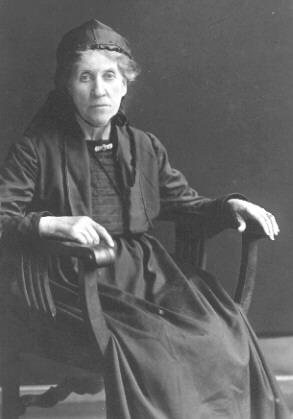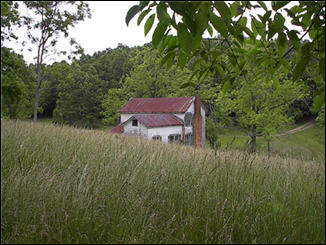Jewell or Jewel Family Genealogy - Family Sketches
Lucinda Jewel Nunley
"Aunt Lucy" by James Jewel Geary
 There is not much information in the files about Hank’s siblings. The closest to his children were: Emeline (Aunt Emma), who lived with Hank until her death in 1890; and Lucinda (Aunt Lucy) and Christina (Aunt Tee) because their homes became homes for various of Hank’s children for extended periods after their mother died. I have only a brief memory of Aunt Tee, but I knew Aunt Lucy well, having visited in her home in the country many times as a small boy and in my teens.
There is not much information in the files about Hank’s siblings. The closest to his children were: Emeline (Aunt Emma), who lived with Hank until her death in 1890; and Lucinda (Aunt Lucy) and Christina (Aunt Tee) because their homes became homes for various of Hank’s children for extended periods after their mother died. I have only a brief memory of Aunt Tee, but I knew Aunt Lucy well, having visited in her home in the country many times as a small boy and in my teens.
My recollection of Aunt Tee is unfortunate. She spent her final years with her sister Lucy and Lucy’s second husband, Isaac Nunley. My one vision of her is of a very old woman, badly bent over, sitting at the dinner table. This boyhood impression was one of uncleanliness. When years later I communicated this view to my mother, she was astounded. "Why," she said, "Aunt Tee was such a fanatic about cleanliness that she rinsed her sheets seven times." She was 87 when she died in 1923. I had the same general impression of Mr. Nunley, an old man, nearly ninety, with a heavy gray beard stained with tobacco, who would precede his getting up from the dinner table with a loud "ohhhhh Lordy."
Hank’s sister Lucinda I never heard addressed or referred to except as "Aunt Lucy." She was born in 1843, and she married James Miller in 1880 when she was 37 years old. He was much older than she, had served in the Civil War, and owned a farm that apparently had been in his family since Colonial days. Iva (author's mother) remembered an old log home with a large fireplace equipped with swinging irons for holding cooking pots. It later burned. Miller appears to have been a sturdy man and skilled with his hands. He may not have lived many years after the marriage, because in 1893 Lucy married Isaac Nunley, a butcher.
Miller had willed the farm to Lucy; and it was this place, no longer a working farm, that I remember. It was a pleasant, isolated tract up a shallow hollow with low undulating ridges on either side. A small singing brook made its way down the grassy meadow. The stream was fed by two springs, one hard-water and one referred to as "free-stone." There were fields for cattle grazing, lots of split rail fences, some woods, and a hillside overgrown with pines. The plain clapboard house sat on a rise about half way between the two springs. It was of a typical, simple style that may date from before the turn of the century. It replaced the old log house.
"Aunt Lucy’s" appears to have been a much visited place for all of Hank’s children, all of whom no doubt spent quite some time there after their mother died. It remained a retreat, a place of refuge, almost a garden of Eden for the three siblings with whom I grew up. And so of course I saw a lot of it.
From my earliest memories until my early twenties I accompanied family members on many visits to Aunt Lucy’s, which lay a few miles west of Christiansburg, about half way to Radford. The trips were always interesting. Usually they were for only a day, Sunday, but sometimes for a weekend or longer.
The earliest trips I remember were in the early 1920s when Virginia was still in the mud. The highway from our home in Roanoke into Southwest Virginia was not exactly muddy, but it was dusty. The final half mile to Aunt Lucy’s, which was off the main highway, always required heroic efforts on the part of car and driver.
En route, one thing was always pointed out by members of this close-knit family, the crypt on the side of the mountain at Elliston where the prosperous Hancock family buried their dead. Our ancestor, Asa Hall, had built that crypt. This made much more impression on a small boy than the fact that he had been a soldier in the Revolutionary War.

Aunt Lucy’s was a delightful place for a young boy to visit. There was no other house in sight. I remember the pleasure of playing along the little brook, bordered by thick grass. Whenever I hear the gurgling of a mountain stream, it takes me back to that little branch. I remember in the woods the chestnut trees with their big green burs lying on the ground. These trees were still living despite the blight that was eradicating the magnificent chestnut forests that used to cover our Virginia mountains. I would help my Uncle Leslie gather wood there for the fireplace. Behind the house was an old falling-down barn. There was a spring house in which Aunt Lucy kept milk and butter in a cement bath. A pipe from the upper soft-water spring brought in the cold water and extended out over the bath. A rock was placed under the stream from the pipe to keep it from wearing the concrete.
The house had two fireplaces, in the two downstairs bedrooms, and there was a cookstove in the kitchen, which also provided some heat to the dining room. I only remember fires in one of the bedrooms. I always slept in one of the two upstairs bedrooms, in a great feather bed that rose up on both sides and engulfed me. I would wake up on cold mornings, warm and cozy, and stare up at the knotty-pine ceiling — hundreds of pine knots it seemed — dreading to get up in the cold. This room always had a special, not unpleasant odor, perhaps in part because that was where Aunt Lucy kept her Native Herbs, a laxative that she sold in boxes resembling kitchen match boxes. All members of the family regarded them as the only thing to take at those special times.
There was, of course, no bathroom. I used to go down to the branch just below the spring house to dash water on my face, and in summer I have bathed in its cold water. I eschewed the rickety old "one-holer" that perched at the end of a former garden, and would instead go up the lane bordered by a rail fence and step into one of the fence alcoves for my morning requirements.
In my earliest memories of the place, there were no screens at the windows; consequently the ceilings were covered with fly specks. In hot weather, just before dinner was served in the small dining room, we would take leafy branches or newspapers to shoo as many flies as we could out of the room. This was only partially successful.
There was an old pie chest in the dining room that I was ashamed of. I thought the pitted tin pieces represented a poor effort to repair a broken piece of furniture. I wonder what happened to it. It would be worth a good deal on today’s antique market, as well as the old organ, the antique clock, and other items of furniture.
One of two bedrooms on the first floor served as a living room. In addition to the bed, there was the organ that my Aunt Vedy would sometimes play and at the same time sing in a terrible falsetto voice. I dreaded it. This was the room in which we gathered in winter, everyone sitting around the fire in little square chairs with cloth bottoms and cloth backs. Aunt Lucy would tell stories of pioneer days that had been told her. I only listened with half attention, unfortunately, but rather would stare into the fire, imagining that the hot interior was hell. I would fancy that I saw the Devil there. Now I have only indistinct memories of her stories. One was of a small boy who was treed by a bear. When the bear finally left, the child ran the long ways home so fast that his nose bled.
Aunt Lucy was in her 80's during most of the time I knew her. She had soft pink, largely unwrinkled complexion. When outside she wore a large black bonnet to shield her face and her eyes from the sun. Her eyes were a pale blue, and she must have had "second sight" because she could read a newspaper in a good light without her glasses. Mostly she read her Bible. The family was amazed that she wore a 2 ½ size shoe. I have seen her on a hot summer day hoeing potatoes in her garden with her large black bonnet on and her body encased in several petticoats as well as a dress. When I first visited at her place, I seem to recall she still had a horse that she could hitch to her buggy.
She had a good sense of humor and could chuckle with a soft musical laugh. But she could be stubborn. My mother and I were visiting her when she caught in a trap a fox or a raccoon or something that she said had been killing her chickens. My mother was outraged at the animal’s suffering and said she was going to turn it loose. I heard Aunt Lucy loudly protesting that she would cut Iva out of her will. "I don’t give a damn about the will," my mother replied. I don’t remember the outcome of this encounter.
In her late eighties Aunt Lucy, a life-long Methodist, decided she wanted to join the Dunkard (Brethren) church because of its foot-washing ceremony. She had read in her Bible that is what Jesus did. So my Aunt Vedy and I drove her into Christiansburg so she could join the church. Whether she ever attended any services, I don’t know.
She lived to be 90, a strong-willed, beloved old lady who lived by herself until the end except for those times when some member of the family spent time at the place for its peace and quiet and memories of long ago.
We recently discovered the cemetery where Lucy and her first husband are buried.

